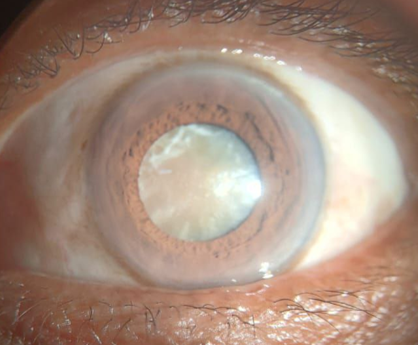Avoidable vision problems
Instruction
In this topic you will learn about avoidable vision problems that people may experience.
Common avoidable problems with vision involve:
- Problems seeing clearly (refractive error)
- Cataracts (cloudy vision).
Problems seeing clearly (refractive error)
This is due to the shape of a person’s eye.
Refractive error leads to:
- Distance vision problems (myopia or short-sighted): People who are short-sighted can see things that are near but have difficulty seeing things in the distance.
- Near vision problems (hyperopia or long-sighted): People who are long-sighted can see things clearly in the distance but have difficulty seeing things that are near.
- Near vision problems in older adults (presbyopia): People with presbyopia have difficulty seeing things that are near. Presbyopia only occurs as people reach the age of 40 or more. They may notice that near tasks become more difficult, or their eyes get tired with near tasks.
- Astigmatism (distance and near vision problems): People with astigmatism have difficulty seeing things that are near and in the distance.
Activity
Compare the four images below to see how distance vision problems (short-sighted), near vision problems (long-sighted), near vision problems in older adults (presbyopia) and astigmatism (distance and near vision problems) can affect what a person sees.

No vision problem

Distance vision problem (short-sighted)

Near vision problem (long-sighted), and near vision problem in older adults (presbyopia)

Astigmatism
Distance vision problems, near vision problems and astigmatism can often be corrected or improved with prescription spectacles, contact lenses or surgery.
Meet Alitia

Alitia enjoys school and playing soccer with her friends. Her teacher noticed that she was finding it difficult to see what was written on the classroom board and was losing confidence.
Alitia had an appointment with the local eye health professional. They found that she is short-sighted and was prescribed spectacles. Alitia’s confidence has returned, and she is doing well at school.
Near vision problems for older adults (presbyopia) can be improved with near vision spectacles.
These are different to prescription spectacles.
Instruction
You will learn how to provide near vision spectacles to people with near vision problems for older adults in the Managing vision and eye health problems module.
Question

Meet Malik
Malik is a tailor aged 45 years old. He recently began using near vision spectacles to read stories to his grandson and to sew.
What vision problem do you think Malik has?
Select one.
If you selected c, you are correct!
Malik has a near vision problem in older adults (presbyopia). This is because his vision problem began as he became older, and it affects seeing things that are near.
Discussion
- Do you, or does anyone you know, wear spectacles?
- Are spectacles easily available in your area?
- What would be the effect on a person who needs spectacles but does not have access to them?
Discuss with your colleagues.
Cataracts (cloudy vision)
This is caused by clouding of the eye’s lens, which can be seen as a clouding in the central coloured part of the eye (pupil). It is usually due to age.
Cataracts lead to:
- Distance and near vision problems
- Increased sensitivity to bright light.

Photo credit: LV Prasad Eye Institute, India
Instruction
You will learn more about cataracts in Lesson two: Healthy eyes and common eye health problems.

